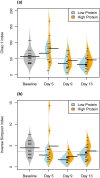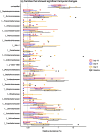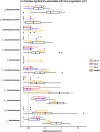Temporal and nutritional effects on the weaner pig ileal microbiota
- PMID: 34454628
- PMCID: PMC8403407
- DOI: 10.1186/s42523-021-00119-y
Temporal and nutritional effects on the weaner pig ileal microbiota
Abstract
Background: The porcine gastrointestinal microbiota has been linked to both host health and performance. Most pig gut microbiota studies target faecal material, which is not representative of microbiota dynamics in other discrete gut sections. The weaning transition period in pigs is a key development stage, with gastrointestinal problems being prominent after often sudden introduction to a solid diet. A better understanding of both temporal and nutritional effects on the small intestinal microbiota is required. Here, the development of the porcine ileal microbiota under differing levels of dietary protein was observed over the immediate post-weaning period.
Results: Ileal digesta samples were obtained at post-mortem prior to weaning day (day - 1) for baseline measurements. The remaining pigs were introduced to either an 18% (low) or 23% (high) protein diet on weaning day (day 0) and further ileal digesta sampling was carried out at days 5, 9 and 13 post-weaning. We identified significant changes in microbiome structure (P = 0.01), a reduction in microbiome richness (P = 0.02) and changes in the abundance of specific bacterial taxa from baseline until 13 days post-weaning. The ileal microbiota became less stable after the introduction to a solid diet at weaning (P = 0.036), was highly variable between pigs and no relationship was observed between average daily weight gain and microbiota composition. The ileal microbiota was less stable in pigs fed the high protein diet (P = 0.05), with several pathogenic bacterial genera being significantly higher in abundance in this group. Samples from the low protein and high protein groups did not cluster separately by their CAZyme (carbohydrate-active enzyme) composition, but GH33 exosialidases were found to be significantly more abundant in the HP group (P = 0.006).
Conclusions: The weaner pig ileal microbiota changed rapidly and was initially destabilised by the sudden introduction to feed. Nutritional composition influenced ileal microbiota development, with the high protein diet being associated with an increased abundance of significant porcine pathogens and the upregulation of GH33 exosialidases-which can influence host-microbe interactions and pathogenicity. These findings contribute to our understanding of a lesser studied gut compartment that is not only a key site of digestion, but also a target for the development of nutritional interventions to improve gut health and host growth performance during the critical weaning transition period.
Keywords: Gut; Ileum; Metagenomics; Microbiome; Microbiota; Nutrition; Pigs; Protein; Weaning.
© 2021. The Author(s).
Conflict of interest statement
The authors declare that they have no competing interests.
Figures








Similar articles
-
Changes in the Ileal, but Not Fecal, Microbiome in Response to Increased Dietary Protein Level and Enterotoxigenic Escherichia coli Exposure in Pigs.Appl Environ Microbiol. 2019 Sep 17;85(19):e01252-19. doi: 10.1128/AEM.01252-19. Print 2019 Oct 1. Appl Environ Microbiol. 2019. PMID: 31324635 Free PMC article.
-
Alterations of the Viable Ileal Microbiota of the Gut Mucosa-Lymph Node Axis in Pigs Fed Phytase and Lactic Acid-Treated Cereals.Appl Environ Microbiol. 2020 Feb 3;86(4):e02128-19. doi: 10.1128/AEM.02128-19. Print 2020 Feb 3. Appl Environ Microbiol. 2020. PMID: 31757823 Free PMC article.
-
The impact of epidermal growth factor supernatant on pig performance and ileal microbiota.Transl Anim Sci. 2018 May 18;2(2):184-194. doi: 10.1093/tas/txy019. eCollection 2018 Apr. Transl Anim Sci. 2018. PMID: 32704702 Free PMC article.
-
The role of lactose in weanling pig nutrition: a literature and meta-analysis review.J Anim Sci Biotechnol. 2021 Jan 11;12(1):10. doi: 10.1186/s40104-020-00522-6. J Anim Sci Biotechnol. 2021. PMID: 33431022 Free PMC article. Review.
-
Timely Control of Gastrointestinal Eubiosis: A Strategic Pillar of Pig Health.Microorganisms. 2021 Feb 3;9(2):313. doi: 10.3390/microorganisms9020313. Microorganisms. 2021. PMID: 33546450 Free PMC article. Review.
Cited by
-
Topological and spatial heterogeneity of gut microbiota co-abundance networks in pigs revealed by using large-scale samples.Front Microbiol. 2025 Jun 25;16:1578236. doi: 10.3389/fmicb.2025.1578236. eCollection 2025. Front Microbiol. 2025. PMID: 40636485 Free PMC article. Review.
-
Lactobacillus and Saccharomyces fermentation products impact performance and the fecal microbiome in weanling pigs inoculated with enterotoxigenic Escherichia coli.J Anim Sci. 2025 Jan 4;103:skae394. doi: 10.1093/jas/skae394. J Anim Sci. 2025. PMID: 39841163 Free PMC article.
-
Dietary Supplementation with Botanical Blends Modified Intestinal Microbiota and Metabolomics of Weaned Pigs Experimentally Infected with Enterotoxigenic Escherichia coli.Microorganisms. 2023 Jan 27;11(2):320. doi: 10.3390/microorganisms11020320. Microorganisms. 2023. PMID: 36838285 Free PMC article.
-
Capture and Ex-Situ Analysis of Environmental Biofilms in Livestock Buildings.Microorganisms. 2021 Dec 21;10(1):2. doi: 10.3390/microorganisms10010002. Microorganisms. 2021. PMID: 35056451 Free PMC article.
-
Microbiota modulation by the inclusion of Tenebrio molitor larvae as alternative to fermented soy protein concentrate in growing pigs diet.Vet Res Commun. 2024 Nov 21;49(1):26. doi: 10.1007/s11259-024-10588-6. Vet Res Commun. 2024. PMID: 39570524
References
-
- Zhang W, Wu Q, Zhu Y, Yang G, Yu J, Wang J, et al. Probiotic Lactobacillus rhamnosus GG induces alterations in ileal microbiota with associated CD3-CD19-T-bet+IFNγ+/− cell subset homeostasis in pigs challenged with Salmonella enterica serovar 4,[5],12:i:- Front Microbiol. 2019;10:1–17. doi: 10.3389/fmicb.2019.00001. - DOI - PMC - PubMed
Grants and funding
LinkOut - more resources
Full Text Sources
Research Materials
Miscellaneous
